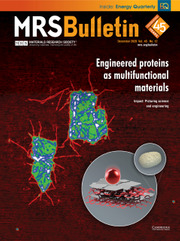Crossref Citations
This article has been cited by the following publications. This list is generated based on data provided by
Crossref.
Li, Suzhi
Ding, Xiangdong
Deng, Junkai
Lookman, Turab
Li, Ju
Ren, Xiaobing
Sun, Jun
and
Saxena, Avadh
2010.
Superelasticity in bcc nanowires by a reversible twinning mechanism.
Physical Review B,
Vol. 82,
Issue. 20,
Türk, Christian
Carbone, Anna
and
Chiaia, Bernardino M.
2010.
Fractal heterogeneous media.
Physical Review E,
Vol. 81,
Issue. 2,
Dhote, R.P.
Melnik, R.V.N.
and
Zu, J.
2012.
Dynamic thermo-mechanical coupling and size effects in finite shape memory alloy nanostructures.
Computational Materials Science,
Vol. 63,
Issue. ,
p.
105.
Littlewood, Peter B.
2012.
Disorder and Strain-Induced Complexity in Functional Materials.
Vol. 148,
Issue. ,
p.
95.
Lloveras, Pol
Castán, Teresa
Planes, Antoni
and
Saxena, Avadh
2012.
Disorder and Strain-Induced Complexity in Functional Materials.
Vol. 148,
Issue. ,
p.
227.
Castán, Teresa
Planes, Antoni
and
Saxena, Avadh
2013.
Precursor Nanoscale Textures in Ferroelastics: Interplay between Anisotropy and Disorder.
Materials Science Forum,
Vol. 738-739,
Issue. ,
p.
155.
Ahn, K. H.
Seman, T. F.
Lookman, T.
and
Bishop, A. R.
2013.
Role of complex energy landscapes and strains in multiscale inhomogeneities in perovskite manganites.
Physical Review B,
Vol. 88,
Issue. 14,
Zhang, Zhen
Ding, Xiangdong
Deng, Junkai
Cui, Jian
Sun, Jun
Suzuki, Tetsuro
Otsuka, Kazuhiro
and
Ren, Xiaobing
2013.
Surface Effects on Structural Phase Transformations in Nanosized Shape Memory Alloys.
The Journal of Physical Chemistry C,
Vol. 117,
Issue. 15,
p.
7895.
Waitz, T.
Schranz, W.
and
Tröster, A.
2014.
Mesoscopic Phenomena in Multifunctional Materials.
Vol. 198,
Issue. ,
p.
23.
Monroe, J.A.
Raymond, J.E.
Xu, X.
Nagasako, M.
Kainuma, R.
Chumlyakov, Y.I.
Arroyave, R.
and
Karaman, I.
2015.
Multiple ferroic glasses via ordering.
Acta Materialia,
Vol. 101,
Issue. ,
p.
107.
Zhang, Dawei
Yao, Yonggang
Fang, Minxia
Luo, Zhengdong
Zhang, Lixue
Li, Linglong
Cui, Jian
Zhou, Zhijian
Bian, Jihong
Ren, Xiaobing
and
Yang, Yaodong
2016.
Isothermal phase transition and the transition temperature limitation in the lead-free (1-x)Bi0.5Na0.5TiO3-xBaTiO3 system.
Acta Materialia,
Vol. 103,
Issue. ,
p.
746.
Baigutlin, D. R.
Sokolovskiy, V. V.
Miroshkina, O. N.
Zagrebin, M. A.
Nokelainen, J.
Pulkkinen, A.
Barbiellini, B.
Pussi, K.
Lähderanta, E.
Buchelnikov, V. D.
and
Zayak, A. T.
2020.
Electronic structure beyond the generalized gradient approximation for
Ni2MnGa.
Physical Review B,
Vol. 102,
Issue. 4,
Pussi, K
Barbiellini, B
Ohara, K
Yamada, H
Dwivedi, J
Bansil, A
Gupta, A
and
Kamali, S
2021.
Atomic arrangements in an amorphous CoFeB ribbon extracted via an analysis of radial distribution functions.
Journal of Physics: Condensed Matter,
Vol. 33,
Issue. 39,
p.
395801.
Pussi, K
Louzguine-Luzgin, D V
Nokelaineni, J
Barbiellini, B
Kothalawala, V
Ohara, K
Yamada, H
Bansil, A
and
Kamali, S
2022.
Atomic structure of an FeCrMoCBY metallic glass revealed by high energy x-ray diffraction.
Journal of Physics: Condensed Matter,
Vol. 34,
Issue. 28,
p.
285301.




